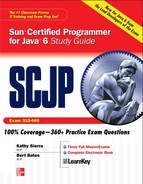Which letters will eventually appear somewhere in the output (Choose all that apply.)
A. A
B. B
C. C
D. D
E. E
F. F
G. The answer cannot be reliably determined
H. The code does not compile
13. Given:

And given the following five fragments:

When the five fragments are inserted, one at a time at line 9, which are true (Choose all that apply.)
A. All five will compile
B. Only one might produce the output 4 4
C. Only one might produce the output 4 2
D. Exactly two might produce the output 4 4
E. Exactly two might produce the output 4 2
F. Exactly three might produce the output 4 4
G. Exactly three might produce the output 4 2
14. Given:
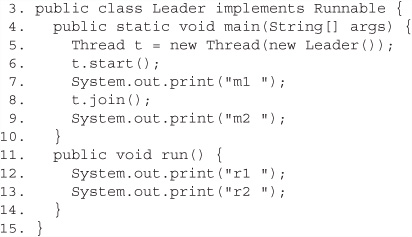
Which are true (Choose all that apply.)
A. Compilation fails
B. The output could be r1 r2 m1 m2
C. The output could be m1 m2 r1 r2
D. The output could be m1 r1 r2 m2
E. The output could be m1 r1 m2 r2
F. An exception is thrown at runtime
15. Given:
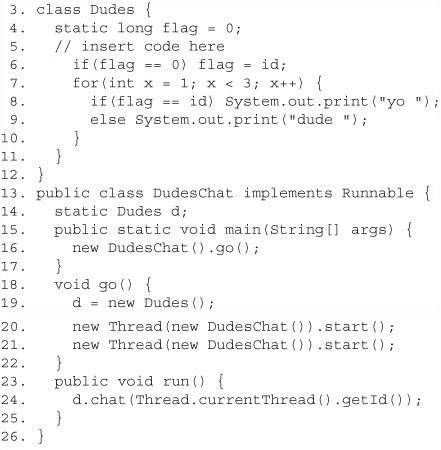
And given these two fragments:
![]()
When fragment I or fragment II is inserted at line 5, which are true (Choose all that apply.)
A. An exception is thrown at runtime
B. With fragment I, compilation fails
C. With fragment II, compilation fails
D. With fragment I, the output could be yo dude dude yo
E. With fragment I, the output could be dude dude yo yo
F. With fragment II, the output could be yo dude dude yo
16. Given:

Which are true (Choose all that apply.)
A. Compilation fails
B. The output could be 4 4 2 3
C. The output could be 4 4 2 2
D. The output could be 4 4 4 2
E. The output could be 2 2 4 4
F. An exception is thrown at runtime
17. Given:

And given these two fragments:
![]()
When either fragment I or fragment II is inserted at line 7, which are true (Choose all that apply.)
A. Compilation fails
B. With fragment I, an exception is thrown
C. With fragment I, the output could be 4 2 4 2
D. With fragment I, the output could be 4 4 2 3
E. With fragment II, the output could be 2 4 2 4
SELF TEST ANSWERS
1. The following block of code creates a Thread using a Runnable target:
![]()
Which of the following classes can be used to create the target, so that the preceding code compiles correctly
A. public class MyRunnable extends Runnable{public void run(){}}
B. public class MyRunnable extends Object{public void run(){}}
C. public class MyRunnable implements Runnable{public void run(){}}
D. public class MyRunnable implements Runnable{void run(){}}
E. public class MyRunnable implements Runnable{public void start(){}}
Answer: |
|
|
|
|
2. Given:
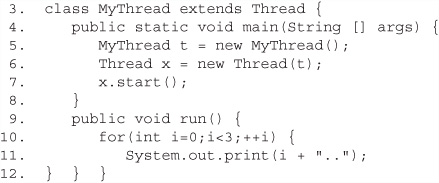
What is the result of this code
A. Compilation fails
B. 1..2..3..
C. 0..1..2..3..
D. 0..1..2..
E. An exception occurs at runtime
Answer: |
|
|
|
|

The static method Thread.currentThread() returns a reference to the currently executing Thread object. What is the result of this code?
A. Each String in the array lines will print, with exactly a 1-second pause between lines
B. Each String in the array lines will print, with no pause in between because this method is not executed in a Thread
C. Each String in the array lines will print, and there is no guarantee there will be a pause because currentThread() may not retrieve this thread
D. This code will not compile
E. Each String in the lines array will print, with at least a one-second pause between lines
Answer: |
|
|
|
|
4. Assume you have a class that holds two private variables: a and b. Which of the following pairs can prevent concurrent access problems in that class (Choose all that apply.)
A. public int read(){return a+b;}
public void set(int a, int b){this.a=a;this.b=b;}
B. public synchronized int read(){return a+b;}
public synchronized void set(int a, int b){this.a=a;this.b=b;}
C. public int read(){synchronized(a){return a+b;}}
public void set(int a, int b){synchronized(a){this.a=a;this.b=b;}}
D. public int read(){synchronized(a){return a+b;}}
public void set(int a, int b){synchronized(b){this.a=a;this.b=b;}}
E. public synchronized(this) int read(){return a+b;}
public synchronized(this) void set(int a, int b){this.a=a;this.b=b;}
F. public int read(){synchronized(this){return a+b;}}
public void set(int a, int b){synchronized(this){this.a=a;this.b=b;}}
Answer: |
|
|
|
|
5. Given:
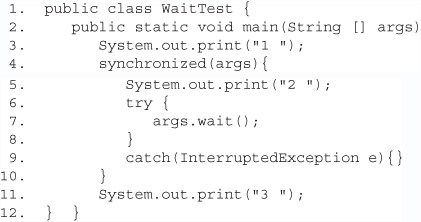
What is the result of trying to compile and run this program
A. It fails to compile because the IllegalMonitorStateException of wait() is not dealt with in line 7
B. 1 2 3
C. 1 3
D. 1 2
E. At runtime, it throws an IllegalMonitorStateException when trying to wait
F. It will fail to compile because it has to be synchronized on the this object
Answer: |
|
|
|
|
6. Assume the following method is properly synchronized and called from a thread A on an object B:
wait(2000);
After calling this method, when will the thread A become a candidate to get another turn at the CPU
A. After object B is notified, or after two seconds
B. After the lock on B is released, or after two seconds
C. Two seconds after object B is notified
D. Two seconds after lock B is released
Answer: |
|
|
|
|
7. Which are true (Choose all that apply.)
A. The notifyAll() method must be called from a synchronized context
B. To call wait(), an object must own the lock on the thread
C. The notify() method is defined in class java.lang.Thread
D. When a thread is waiting as a result of wait(), it releases its lock
E. The notify() method causes a thread to immediately release its lock
F. The difference between notify() and notifyAll() is that notifyAll() notifies all waiting threads, regardless of the object they're waiting on
Answer: |
|
|
|
|
8. Given the scenario: This class is intended to allow users to write a series of messages, so that each message is identified with a timestamp and the name of the thread that wrote the message:


How can we ensure that instances of this class can be safely used by multiple threads
A. This class is already thread-safe
B. Replacing StringBuilder with StringBuffer will make this class thread-safe
C. Synchronize the log() method only
D. Synchronize the getContents() method only
E. Synchronize both log() and getContents()
F. This class cannot be made thread-safe
Answer: |
|
|
|
|
9. Given:

What is the result of this code
A. It prints X and exits
B. It prints X and never exits
C. It prints XY and exits almost immeditately
D. It prints XY with a 10-second delay between X and Y
E. It prints XY with a 10000-second delay between X and Y
F. The code does not compile
G. An exception is thrown at runtime
Answer: |
|
|
|
|
10. Given:

What is the result
A. foo
B. MyThread foo
C. MyThread bar
D. foo bar
E. foo bar baz
F. bar foo
G. Compilation fails
H. An exception is thrown at runtime
Answer: |
|
|
|
|
11. Given:

Which of the following pairs of method invocations could NEVER be executing at the same time (Choose all that apply.)
A. x.a() in thread1, and x.a() in thread2
B. x.a() in thread1, and x.b() in thread2
C. x.a() in thread1, and y.a() in thread2
D. x.a() in thread1, and y.b() in thread2
E. x.b() in thread1, and x.a() in thread2
F. x.b() in thread1, and x.b() in thread2
G. x.b() in thread1, and y.a() in thread2
H. x.b() in thread1, and y.b() in thread2
Answer: |
|
|
|
|
12. Given:

Which letters will eventually appear somewhere in the output (Choose all that apply.)
A. A
B. B
C. C
D. D
E. E
F. F
G. The answer cannot be reliably determined
H. The code does not compile
Answer: |
|
|
|
|
13. Given:

And given the following five fragments:

When the five fragments are inserted, one at a time at line 9, which are true (Choose all that apply.)
A. All five will compile
B. Only one might produce the output 4 4
C. Only one might produce the output 4 2
D. Exactly two might produce the output 4 4
E. Exactly two might produce the output 4 2
F. Exactly three might produce the output 4 4
G. Exactly three might produce the output 4 2
Answer: |
|
|
|
|
14. Given:

Which are true (Choose all that apply.)
A. Compilation fails
B. The output could be r1 r2 m1 m2
C. The output could be m1 m2 r1 r2
D. The output could be m1 r1 r2 m2
E. The output could be m1 r1 m2 r2
F. An exception is thrown at runtime
Answer: |
|
|
|
|
15. Given:
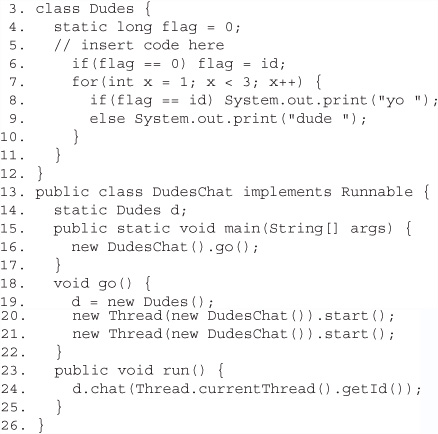
And given these two fragments:
![]()
When fragment I or fragment II is inserted at line 5, which are true (Choose all that apply.)
A. An exception is thrown at runtime
B. With fragment I, compilation fails
C. With fragment II, compilation fails
D. With fragment I, the output could be yo dude dude yo
E. With fragment I, the output could be dude dude yo yo
F. With fragment II, the output could be yo dude dude yo
Answer: |
|
|
|
|
16. Given:
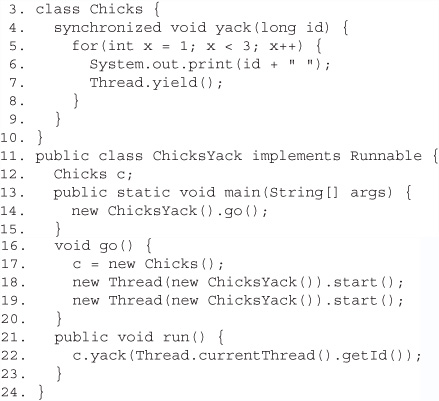
Which are true (Choose all that apply.)
A. Compilation fails
B. The output could be 4 4 2 3
C. The output could be 4 4 2 2
D. The output could be 4 4 4 2
E. The output could be 2 2 4 4
F. An exception is thrown at runtime
Answer: |
|
|
|
|
17. Given:

And given these two fragments:
![]()
When either fragment I or fragment II is inserted at line 7, which are true (Choose all that apply.)
A. Compilation fails
B. With fragment I, an exception is thrown
C. With fragment I, the output could be 4 2 4 2
D. With fragment I, the output could be 4 4 2 3
E. With fragment II, the output could be 2 4 2 4
Answer: |
|
|
|
|
EXERCISE ANSWERS
EXERCISE 9-1: Creating a Thread and Putting It to Sleep
The final code should look something like this:

EXERCISE 9-2: Synchronizing a Block of Code
Your code might look something like this when completed:
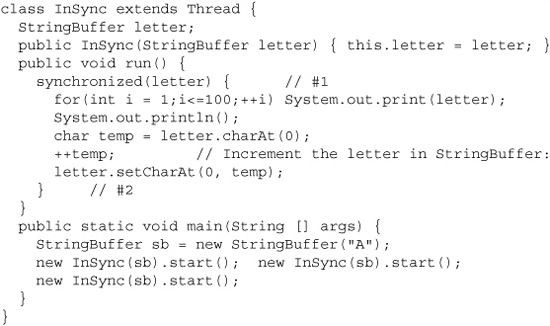
Just for fun, try removing lines 1 and 2 then run the program again. It will be unsynchronized—watch what happens.
